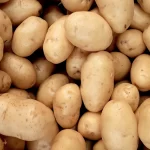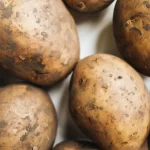Importance of Pest and Disease Control in Potato Cultivation
Potato cultivation is susceptible to a wide variety of pests and diseases that can significantly affect the yield and quality of tubers. Integrated and effective management is crucial to minimizing losses and ensuring sustainable production. In this guide, we explore the most common pests and diseases, as well as recommended control strategies.
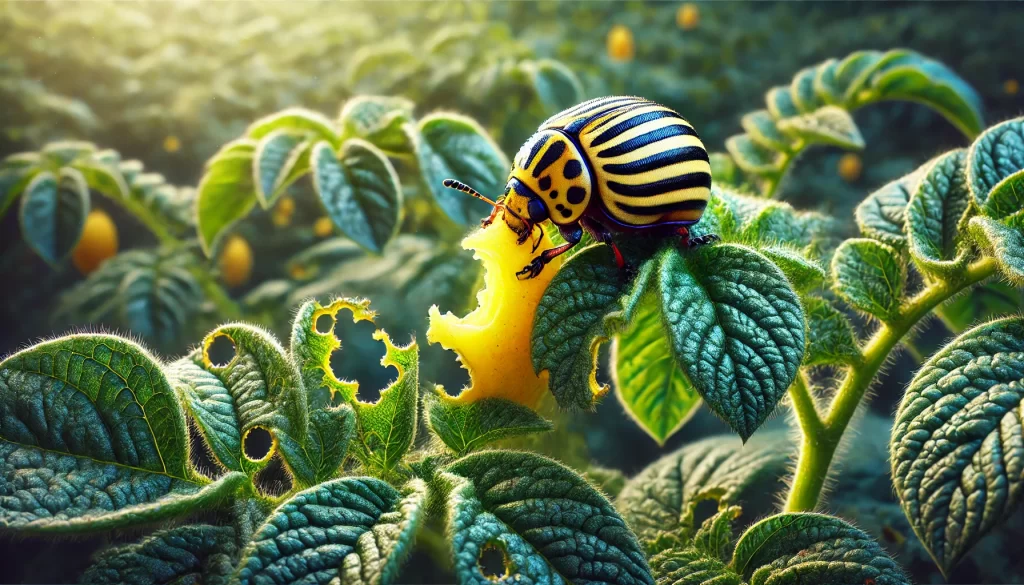
Major Pests Affecting Potato Cultivation
Potato Beetle (Leptinotarsa decemlineata)
Description and Life Cycle
The potato beetle is one of the most destructive pests in potato cultivation. Adults are yellow with black stripes on their wings, and the larvae are reddish-orange with black spots.
- Life Cycle: It begins in spring with the emergence of overwintering adults. Females lay eggs on the underside of leaves, and larvae emerge in a few days, causing considerable damage by feeding on the leaves.
Control Strategies
- Biological Control: Introduction of natural predators such as ladybugs and lacewings.
- Crop Rotation: Alternate with non-solanaceous crops to disrupt the beetle’s life cycle.
- Insecticide Application: Use of specific products such as neonicotinoids or pyrethroids, following technical recommendations to avoid resistance.
Potato Aphid (Myzus persicae)
Description and Life Cycle
The potato aphid is a small, green or yellow insect that feeds on the sap of leaves. In addition to its direct damage, it is a vector for viruses such as the potato leafroll virus.
- Life Cycle: Aphids reproduce rapidly, especially in warm, dry conditions. Colonies can grow exponentially, causing deformities and weakening of plants.

Control Strategies
- Regular Monitoring: Regularly inspect crops to detect early infestations.
- Biological Control: Use parasitoids such as Aphidius colemani and predators such as Chrysoperla carnea.
- Use of Systemic Insecticides: Applications of systemic insecticides to reduce aphid populations and prevent virus transmission.
Wireworm (Agriotes spp.)
Description and Life Cycle
The wireworm, the larva of click beetles, feeds on potato tubers, causing holes and severely damaging the quality of the product.
- Life Cycle: Wireworms have a long life cycle, often remaining in the soil for several years. The larvae develop in soils rich in organic matter.
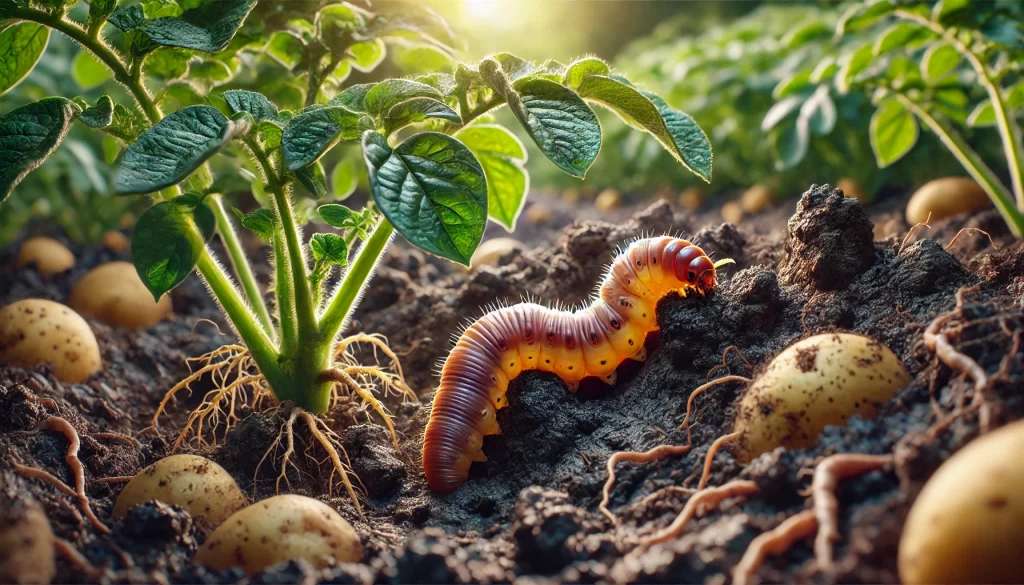
Control Strategies
- Crop Rotation: Alternate with non-host crops to reduce larval populations.
- Use of Traps: Implement baited traps to monitor and reduce wireworm populations.
- Soil Treatment: Apply entomopathogenic nematodes or specific insecticides to the soil before planting.
Major Diseases Affecting Potato Cultivation
Late Blight (Phytophthora infestans)
Description and Life Cycle
Late blight is a devastating fungal disease that affects both the foliage and tubers of potatoes. It appears as dark, watery spots on the leaves and can progress rapidly in cool, wet conditions.
- Life Cycle: The fungus survives in infected tubers and plant debris. It spreads rapidly through spores carried by wind or water.

Control Strategies
- Use of Resistant Varieties: Plant varieties that are less susceptible to late blight.
- Irrigation Management: Avoid overhead irrigation and reduce leaf moisture to minimize favorable conditions for the fungus.
- Fungicide Application: Use preventive and curative fungicides such as mancozeb or fosetyl-aluminum, applied according to local recommendations and weather conditions.
Common Scab (Streptomyces spp.)
Description and Life Cycle
Common scab is a bacterial disease that affects the surface of tubers, causing rough, corky lesions that affect the appearance and commercial quality of potatoes.
- Life Cycle: The bacteria responsible for common scab can survive in the soil for several years and are activated in alkaline and dry soil conditions.
Control Strategies
- Soil pH Management: Maintain a slightly acidic soil pH (5.2 to 5.5) to inhibit bacterial growth.
- Crop Rotation: Avoid planting potatoes in infected soils for several years and alternate with non-host crops.
- Proper Irrigation: Maintain consistent soil moisture during tuber development to reduce the incidence of common scab.
Dry Rot (Fusarium spp.)
Description and Life Cycle
Dry rot is a fungal disease that affects potato tubers, especially during storage. Symptoms include sunken, dry, and wrinkled areas on the tubers, leading to significant weight loss and quality degradation.
- Life Cycle: Fusarium fungi can enter tubers through wounds and spread rapidly under improper storage conditions.
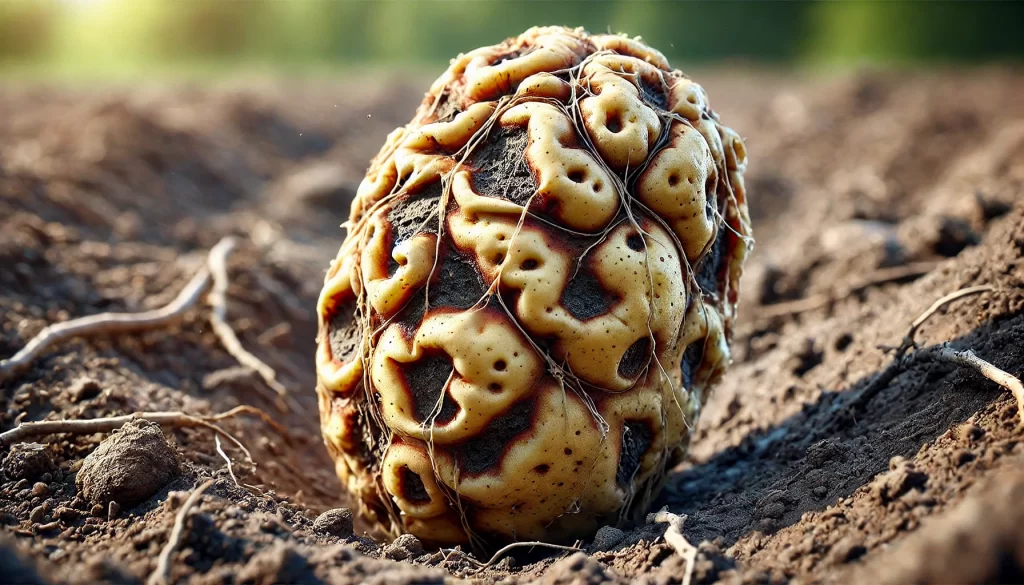
Control Strategies
- Proper Harvest Management: Avoid mechanical damage to tubers during harvest and handling.
- Tuber Curing: Cure tubers in controlled temperature and humidity conditions to allow wounds to heal before storage.
- Storage in Optimal Conditions: Maintain storage temperatures between 4 and 7°C with a relative humidity of 85-90% to inhibit fungal development.
Integrated Pest and Disease Management (IPM) Strategies
Crop Rotation
Crop rotation is one of the most effective strategies to prevent the buildup of pests and diseases in the soil. Alternating potato cultivation with other non-host crops significantly reduces pathogen and pest pressure.
Biological Control
The use of natural enemies, such as predators, parasitoids, and specific pathogens, can be an effective tool in pest management. Additionally, the introduction of beneficial microorganisms in the soil can help control diseases.
Monitoring and Early Detection
Regular crop monitoring allows for the early detection of pests and diseases, facilitating timely intervention and reducing the need for intensive chemical treatments.
Responsible Use of Chemical Products
When the use of insecticides or fungicides is necessary, it is crucial to follow technical recommendations to avoid resistance and minimize environmental impact. This includes rotating products with different modes of action and applying them at the appropriate times.
Cultural Practices and Soil Management
Cultural practices, such as proper soil preparation, the use of organic fertilizers, and irrigation management, contribute to the overall health of the crop and make it more resistant to pests and diseases.
 AgronoBlog – Agriculture Blog
AgronoBlog – Agriculture Blog 